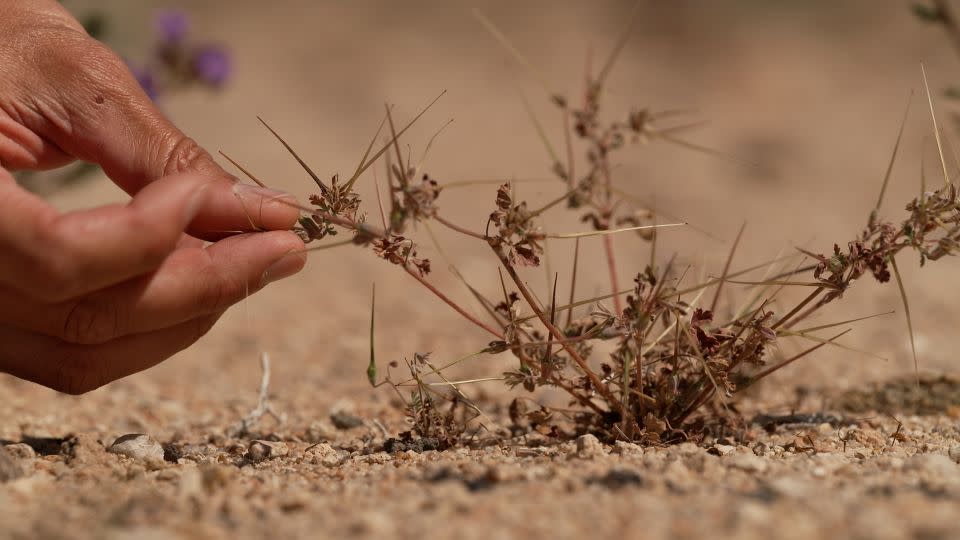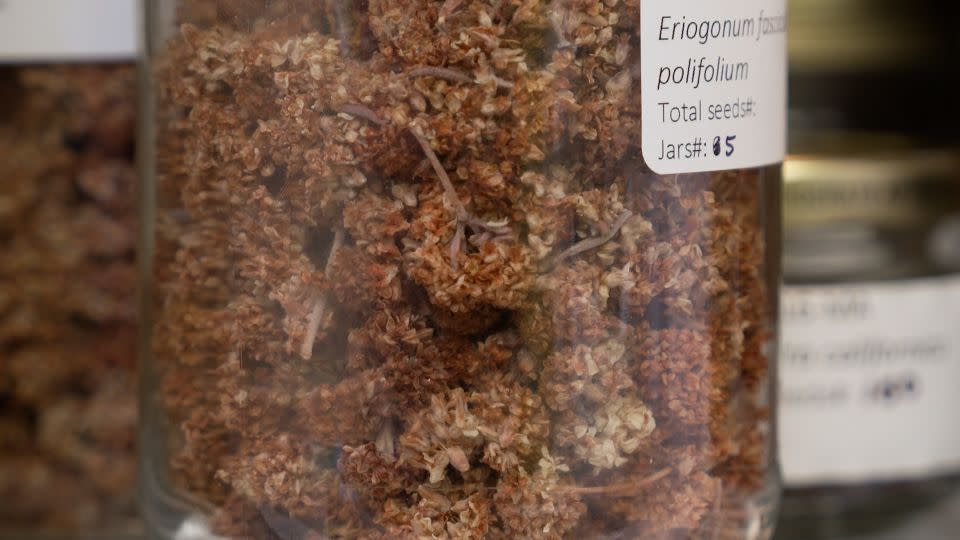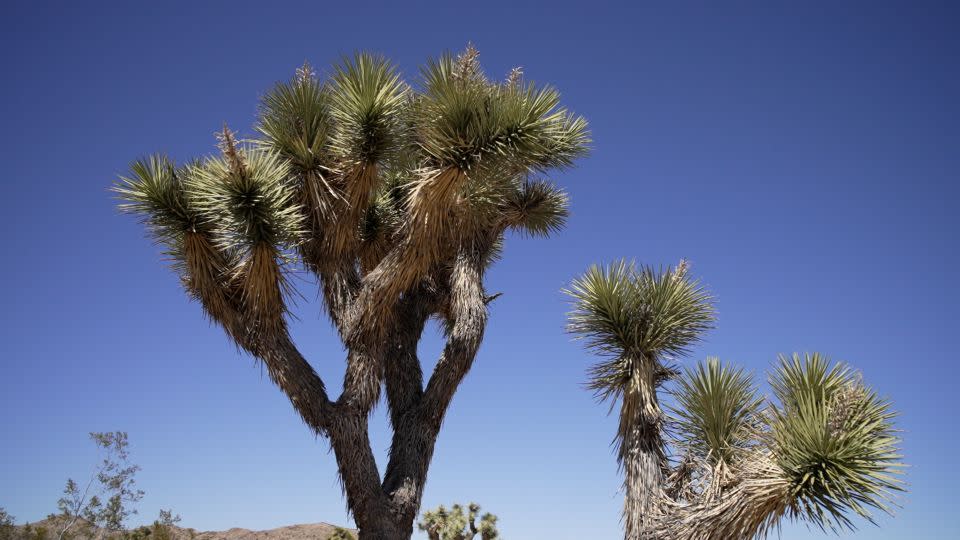Editor’s Note: Call to Earth is a CNN editorial series that aims to report on the environmental challenges facing our planet with solutions. Rolex’s Perpetual Planet initiative has partnered with CNN to raise awareness and education on key sustainability issues and inspire positive action.
A tiny bee is fast asleep inside a Mojave aster flower. At night, the pale lavender leaves close, providing a safe resting area. While the chirping of birds is heard in the desert in the morning, the flower opens and its owner appears.
Here in Southern California, amidst the vast and arid landscape of the Mojave Desert, it’s just one of many natural treasures hidden from view.
Wearing long sleeves, pants and a wide-brimmed hat to protect against the harsh sun under a cloudless blue sky, a team of four people, led by Madena Asbell, crouch in the dirt, searching for another treasure.
They are looking for a plant called erodium texanum (common names Texas stork’s beak or heron’s beak), a species of plant native to California. More specifically, they are looking for its seeds.
“There’s so much life out here, but it’s easy not to notice when you’re in the desert,” Asbell says.
Asbell is director of plant conservation for the Mojave Desert Land Trust (MDLT), a nonprofit land conservation organization that works to preserve and protect California’s Mojave and Colorado desert landscapes.
A quarter of the state is desert and home to approximately 2,400 plant species, according to MDLT. Eight years ago, Asbell had an idea. What if there was a way to preserve the ecosystem that centered around the seeds that facilitate all life there? The result was the Mojave Desert Land Trust seed bank.
“The goal is to preserve this incredible genetic diversity that we have and make it available for species restoration or reintroduction in the event of a disaster that wipes out a population,” Asbell says. “Plants are the foundation of most ecosystems, so when we protect these plants, we also protect everything that depends on them, like desert tortoises, nesting owls and pollinators.”

Five million seeds and counting
Kelly Herbinson, MDLT’s chief executive, says that in an ever-changing environment, the seed bank is the type of “proactive” idea the organization is looking for.
“As a land trust, we recognize that simply preserving land or purchasing land to preserve it is not enough, we need to take extra steps to actually invest in that land,” Herbinson says.
In 2016, the Mojave Desert Land Trust officially launched the seed bank project that has been described as a “Noah’s Ark” for Southern California.
The collection is housed in three white refrigerators at MDLT headquarters in Joshua Tree, California. According to the land trust, there are more than 5 million seeds from about 250 species and the number is growing.
Seeds arrive from field teams and are subjected to a “cut test” to determine viability; It is confirmed that the seed pods are full and not too damaged by insects or mold, indicating that the seeds are worth saving.
They are then placed in paper bags on shelves to dry before being placed in jars in the refrigerator for long-term storage.
All manner of jar shapes and sizes fill the shelves, from small, donated Gerber baby food jars to larger pickle jars; each adorned with white labels containing the seed name, the number of jars in the collection, and the number of seeds.
Just like the desert itself, the seed bank contains all kinds of diversity. Some seeds are light and thin; some are skinny or round. Others are more intense, like black pepper, and the other is reminiscent of pumpkin seeds. It has shades of brown, red and olive green.
Asbell says work at the seed bank includes discovery, collection, processing and database management.
Last year, MDLT received a $3.2 million grant from the California State Wildlife Conservation Board to help expand the project.


“We have already been able to provide seeds to researchers studying the effects of climate change on certain species in our seed bank,” adds Asbell. “And knowing not only what you’re collecting, but also knowing really specifically where it came from is critical to restoration.
“You can’t throw just any seed on the ground… You have to know where that seed comes from, in what population, at what altitude, and make sure it’s the right seed for the right place. “These are the things we can do with the work we do.”
Helping the future of the Joshua tree
The urgency of this task is increasing. Herbinson says California is feeling the effects of climate change, from more frequent and intense wildfires to an influx of invasive grasses that not only choke parts of the desert landscape but also serve as fuel for wildfires.
“Climate change is leading to drought and longer droughts, which really puts a strain on desert ecosystems even though they are drought-adapted,” Asbell says.
“We are facing unprecedented challenges that threaten our existence, and being able to preserve the planet’s genetic diversity at a time when it may be needed in the future is truly amazing; truly critical work,” he adds.
The desert itself is “the kind of place where you can walk by and look and think there’s nothing there,” Herbinson says. “But in reality it is incredibly biodiverse and full of so much life. “It’s just something hidden and hidden in non-obvious ways.”
This means it’s not as well protected as other ecosystems that come with more colorful trees and wildlife, such as rainforests or oceans, he adds.
But the Mojave Desert has its own iconic tree: the Joshua tree.
“We have an incredibly endemic species that is very charismatic and unusual,” says Asbell. “It’s widespread throughout the region, but it’s also very threatened, and so we’re very concerned about the future of the Joshua tree and we’re working really hard to protect it.”
Dr. gave his name to a national park in the same region. The yucca, a twisted Seuss-like species of tree, “is unlikely to survive through our changing climate,” Herbinson concedes, “because its seeds are largely dispersed through the soil.” rodents.”
In order to survive, there will probably come a time when trees will need to migrate to a more “suitable habitat”, ideally somewhere cooler and higher. But this distance is beyond the range of the rodents, which disperse the seeds only 100 feet from the tree. This is where the seed bank can help.
“This means we can potentially help the Joshua tree migrate faster than it naturally would, ensuring the future survival of this species in a changing climate that it wouldn’t survive if we didn’t do this work,” Herbinson says.


Approximately 70,000 Joshua tree seeds are currently stored in the seed bank, and some of them can be planted in cooler locations if necessary. The key, Asbell says, is balance: taking just the right amount to sustain a restoration project in the event of an emergency, but not so much that it disrupts the natural ecosystem.
“This is an old landscape,” he says. “It’s pretty profound to think about how long-lived many of these organisms are and how much history they’ve lived through.”
Asbell adds: “Seeds are life, and I know nothing gives me more joy than growing seeds. … It’s life-affirming. “And in the world we live in today, you really have to hold on to that and keep it close.”
CNN’s Adeline Chen contributed reporting.
For more CNN news and newsletters, create an account at CNN.com